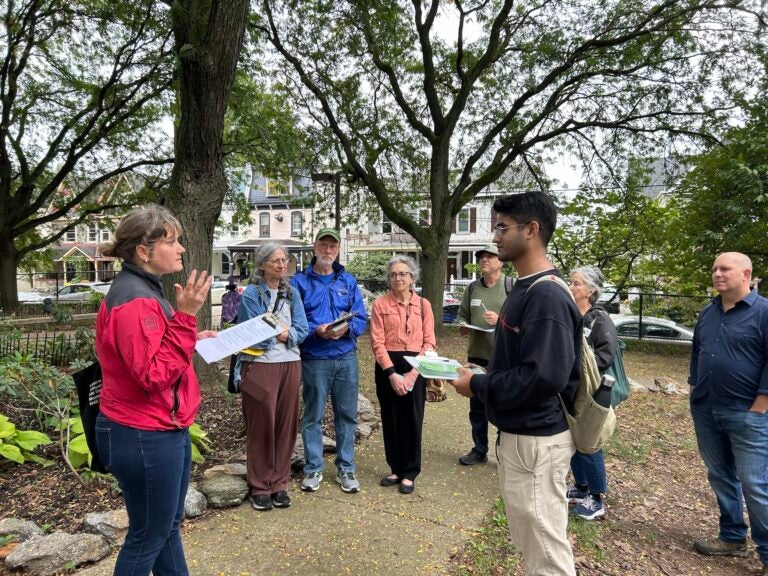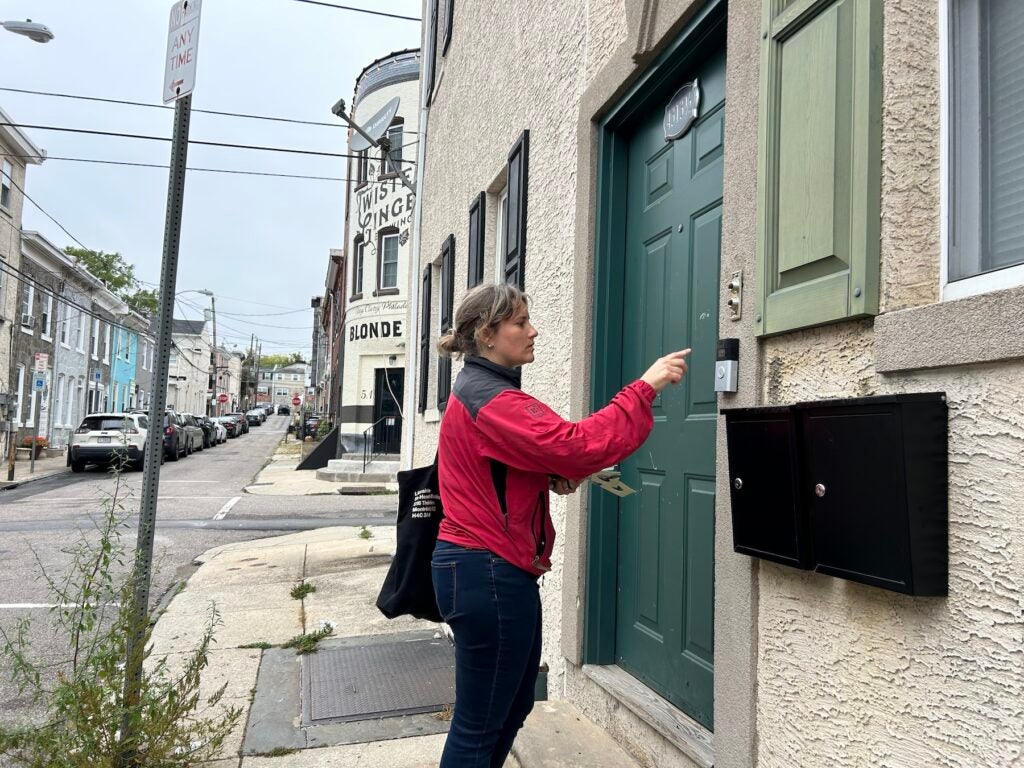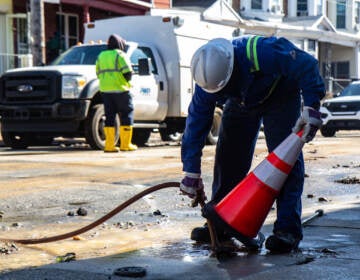Volunteers knock on doors to create climate ‘super-voters’ in Philadelphia
The Environmental Voter Project targets people who are passionate about climate and the environment, but rarely or never vote.
Listen 4:56
Hilary Naiberk and Nikhil Lakhani role play a canvassing interaction to train other Environmental Voter Project volunteers. (Sophia Schmidt/WHYY)
Pa. election 2024: Dates to watch
- Deadline to register to vote: Monday, Oct. 21
- Deadline to apply for a mail or absentee ballot: 5 p.m. on Tuesday, Oct. 29
- Deadline to return mail or absentee ballot: 8 p.m. Tuesday, Nov. 5
This story is part of the WHYY News Climate Desk, bringing you news and solutions for our changing region.
From the Poconos to the Jersey Shore to the mouth of the Delaware Bay, what do you want to know about climate change? What would you like us to cover? Get in touch.
A small group of volunteers gathered at a park in Philly’s Manayunk neighborhood on a recent Sunday, wearing stickers with green check marks on their shirts.
They prepared to fan out across the neighborhood, knocking on the doors of people identified as likely to care about climate and the environment — but who don’t tend to vote on Election Day.
“Today we’re going to be talking to registered voters who are … unlikely to vote in this upcoming election, about getting out to vote,” Hilary Naiberk, a South Philadelphia resident who works in the insurance industry, told her fellow volunteers.
Concerning the presidential race, Pennsylvania will likely be decided by a razor-thin margin, so political canvassers are descending on the state to try and pick up any votes they can — including people who care deeply about climate and the environment, but rarely or never vote.
Naiberk helps lead canvassing in Philadelphia for the Environmental Voter Project, a national nonprofit dedicated to building a base of environmental “super-voters.” Philadelphia is one of four cities where the group is canvassing this fall.
“Politicians will only lead on climate when voters force them to,” said Environmental Voter Project founder Nathaniel Stinnett.
Stinnett says there are two ways the organization could pursue its goal. One option would be to try to convince voters to care more about climate change, which Stinnett says would be “hard and messy and expensive.” The other option is to convince people who already care about climate to vote.
“That’s a little bit easier,” he said.
So, the organization uses surveys to find people who already count climate as their top political priority, Stinnett said. Then, the group uses demographics, where people live and consumer behavior — like whether they’ve recently bought an electric vehicle — to find more people they think have potential to become consistent environmental voters.
“Young people are disproportionately likely to list climate as a top priority,” he said. “The second most likely age group … is people 65 and older.”
The organization has found that people of color — especially Black, Asian American and Pacific Islander, and Native American voters — are more likely to list climate as a top priority than white voters, and women are more likely than men, Stinnett said. The group has also found that people who buy Apple products and partake in outdoor exercise are more likely to list climate and the environment as top priorities.
“It is a combination of 20 or 30 data points that help us identify these folks,” Stinnett said.
The organization is nonpartisan, so their canvassers don’t talk about candidates or parties.
In the presidential race, the two candidates are far apart on climate change. Former President Donald Trump has called climate change a “hoax” and while president, rolled back a number of climate-related rules. While Vice President Kamala Harris has touted the country’s record oil and gas production in recent years, she has also vowed to “tackle the climate crisis” and promoted the federal government’s historic investment in clean energy under the Biden-Harris administration.
Surprisingly, Environmental Voter Project candidates also avoid talking about climate change — unless the potential voter brings it up. Their strategy is simply to get people to commit to show up at the polls, and their main tactic is peer pressure.
“We will call people up and literally say things like, ‘Hey, did you know last time there was an election, 127 of your neighbors on Main Street turned out to vote?’” Stinnett said. “Just pure, juvenile stuff like that that you would hear on a fourth grade playground. But it works.”
The green door hangers the group’s canvassers leave behind when people don’t answer the door include some of that peer pressure: “Who you vote for is secret, but whether you vote is public record.”
Naiberk, the volunteer, knocked on doors, rang doorbells and left these door hangers on row houses in Manayunk for more than an hour before reaching one of the people on her list.

The potential voter didn’t want to talk — but Naiberk was able to squeeze in her question.
“Can we count on you to be a good voter this year, and vote in the election?” she asked.
The target said she could.
Naiberk saw the interaction as a win — and so did the group’s founder, Stinnett.
“You just got them to say that they’re going to vote, and that’s like a trap closing on them,” he said. “Now one of our other volunteers can call them right before the election and say, ‘Hey, remember … you said that you were going to vote? Well, the election’s coming up on Tuesday, and we know you want to keep your promise.’”
The Environmental Voter Project’s strategy of talking about voting instead of climate may seem counterintuitive. But Chris Borick, a public opinion researcher at Muhlenberg College, says it’s smart. Assuming the group’s models are accurate, their targets are already passionate about climate and the environment — but that hasn’t motivated the targets to vote in the past.
“They cared about this issue, yet it didn’t translate into behavior,” Borick said.
Stinnett hopes the group’s canvassing efforts boost turnout in Pennsylvania by a few thousand votes this fall. It would be a small, but potentially important sliver in a state where the past two presidential elections were decided by just tens of thousands of votes.
During the recent canvassing event in Manayunk, the group’s volunteers knocked on close to 250 doors and reached three dozen of their target people. Naiberk felt that collectively, they made a difference building political pressure for climate action, despite not talking about climate change or candidates.
“I want to be a parent, and thinking about the future of my future children … I want to know that I’ve done what I can,” Naiberk said.

Get daily updates from WHYY News!
WHYY is your source for fact-based, in-depth journalism and information. As a nonprofit organization, we rely on financial support from readers like you. Please give today.






